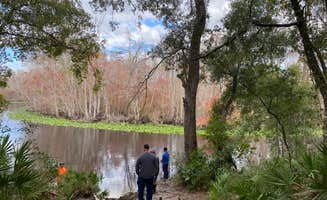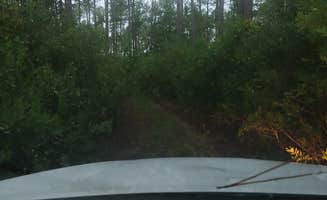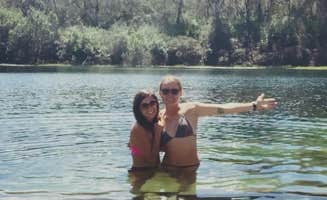Dispersed camping near Fort Mccoy, Florida offers primitive backcountry experiences primarily within the Ocala National Forest. The terrain consists mainly of sandy soil with pine and oak woodlands at elevations generally below 100 feet. Access points vary seasonally, with summer months bringing higher humidity and temperatures regularly exceeding 90°F, while winter nights can occasionally drop below freezing.
What to do
Fishing opportunities: At Davenport Landing, local anglers report productive catches in the Ocklawaha River. According to one visitor, "the fishing was great" with access points near the camping area allowing for both shoreline and small watercraft angling.
Stargazing sessions: The St. Johns River Dispersed Spot provides excellent night sky viewing due to minimal light pollution. One camper noted, "the trees open up so you get a great view of the stars" making this location ideal for astronomical observation.
Historical exploration: Search for Civil War-era gravesites and Timucuan Indian middens along the Ocklawaha River near Davenport Landing. As one experienced camper shares: "If you have an explorer's mindset, you'll be richly rewarded here as there is a small gravesite from the Civil War that you can find along with middens along the Ocklawaha River hiding traces of the Timucuan Indians."
What campers like
Natural swimming holes: Blue Sink offers a unique swimming experience in a natural sinkhole formation. One visitor described it as the "Most beautiful place to stumble upon" despite challenging access requiring "ATV or creative backpacking" since easier routes have been blocked by forestry services.
Wildlife encounters: The diverse ecosystem supports various wildlife viewing opportunities. Campers should remain alert as one visitor to Freak Creek Dispersed Camping mentioned, "I talked to another person that use to go out there and said she has seen a panther."
Seclusion factor: Trout Lake Primitive Sites provides isolation from crowds and development. A reviewer noted these are "Nice secluded sites" that offer privacy despite challenging access routes that require navigating narrow tree clearances.
River access: Multiple sites offer direct water access for paddling activities. At Freak Creek Dispersed Camping, one visitor mentioned it's a "Great place to put a kayak in the water" allowing for exploration of the surrounding waterways.
What you should know
Vehicle requirements: Many sites demand specific vehicles for successful access. For Freak Creek Dispersed Camping, one visitor warned: "If you don't have 4wd and recovery gear I wouldn't risk it" and described water crossings "that was over my bumper on my lifted Mojave."
Variable road conditions: Access deteriorates quickly after rainfall. According to a visitor at Davenport Landing, you'll need to "maneuver around divots and potholes along this narrow gravel, dusty roadway for the better part of 2 miles" and "not exceed 15 MPH on this road as the poor condition of the road could do damage to a lower-lying vehicle."
Safety considerations: Some areas have reported security concerns. A visitor to Lake Dorr reported speaking "to a local that warned of violence, robbery, and killings in this area of the national forest" and that even their "tow truck driver carried a gun because of how unsafe the area is."
Seasonal variations: Summer brings mosquitoes, while winter offers more comfortable camping temperatures but potential for occasional frost. Tree cover at sites like Davenport Landing provides important shade during hot months, with one visitor noting the "medium-sized Magnolias that blot out the sun's rays."
Tips for camping with families
Tree clearance challenges: Vehicle scratches are common on narrow access roads. One visitor to Trout Lake Primitive Sites warned of "Very narrow trails but really easy access, you will leave with some new pinstripes" so consider vehicle protection or using older vehicles when bringing children.
Pack completely self-sufficient: No facilities exist at most sites. A visitor to Davenport Landing emphasized this point: "No picnic tables. No fire ring. No stand-up grill. No potable (or for that matter, non-potable) water spigot. Nothing."
Prepare for terrain variations: Sandy soil can create mobility challenges for young children and strollers. The ground at many sites is "barren and comprised of a combination of dirt and sand silt, which isn't so bad when it's dry, but when there's rain, we're talking some pretty messy mud-like conditions."
Educational opportunities: Multiple campsites offer natural learning experiences with historical significance. Davenport Landing features "a 1.2 mile interpretive hiking trail called Davenport Landing Trail that will take to you to the former steamboat landing, which makes for a medium-grade hike with some interesting history."
Tips from RVers
Size limitations: Small trailers only at select sites. A visitor to Freak Creek Dispersed Camping advised, "I would not attempt bringing a camper unless it's really small" due to narrow access roads and tight turning radiuses.
Recovery equipment: Pack extraction gear for sandy sections. After experiencing difficulties, one visitor recommended, "If you don't have 4wd and recovery gear I wouldn't risk it. There is a nice creek area where you can swim and or fish if you have the right equipment to get back there it can be fun, but if you don't you will be stuck until some one comes by."
Advance scouting: Walk routes before attempting with larger vehicles. A camper at Trout Lake Primitive Sites shared they "Just barely scraped a FWD Promaster through the trees, into a pullout just before sand started" suggesting careful assessment before proceeding with any RV.




